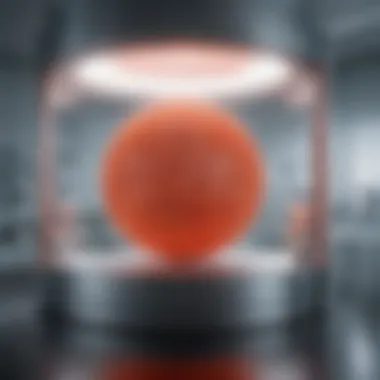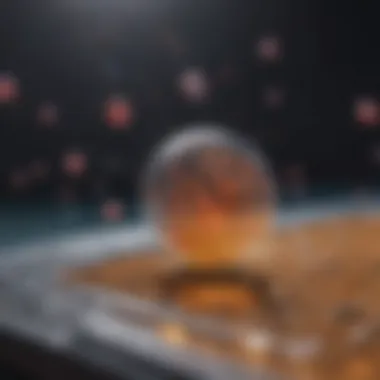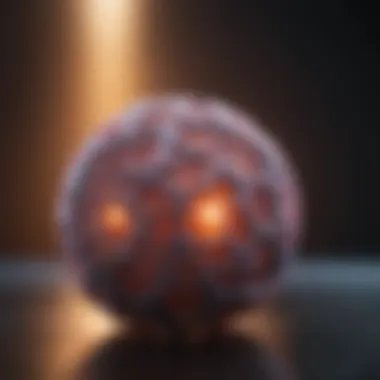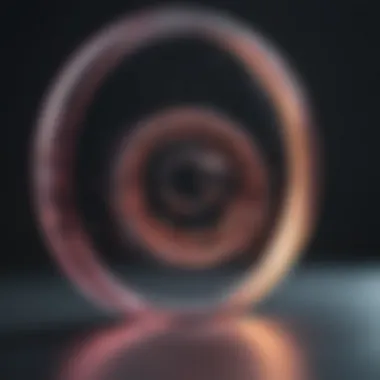Exploring Corning Biocoat Matrigel for Tumor Invasiveness


Intro
The Corning Biocoat Matrigel Invasion Chamber serves as a sophisticated tool in cancer research, aiding scientists in unraveling the complexities of tumor invasion. This chamber enables researchers to assess the invasive properties of cancer cells under controlled laboratory conditions. By mimicking the extracellular matrix, Matrigel provides a realistic environment for studying cellular behaviors that are crucial for understanding cancer progression. The importance of this tool cannot be overstated, as tumor invasiveness is a key factor influencing metastatic potential and therapeutic outcomes.
Research Overview
Summary of Key Findings
Recent investigations utilizing the Corning Biocoat Matrigel Invasion Chamber have highlighted significant insights into cancer cell behavior. Studies demonstrate that various cancer types, such as breast and pancreatic cancers, exhibit unique patterns of invasiveness when exposed to different conditions. Key findings from these studies indicate that:
- Cancer cells alter their morphology and motility when invading through Matrigel.
- Enhanced invasiveness correlates with specific genetic markers and signaling pathways.
- The presence of tumor-associated stromal cells can modify the invasive behavior of cancer cells.
These findings have profound implications for developing targeted therapies that can inhibit tumor spread.
Relevance to Current Scientific Discussions
The exploration of tumor invasiveness in the context of in vitro studies remains crucial to the broader discourse in cancer biology. The Corning Biocoat Matrigel Invasion Chamber is significant because it bridges the gap between basic research and clinical applications. Discussions surrounding therapeutic strategies increasingly emphasize the need to target the invasive characteristics of tumors. Moreover, the chamber allows for the examination of how treatments may differentially influence invasive behavior. This knowledge drives the development of innovative approaches in cancer management.
Methodology
Research Design and Approach
Studies employing the Corning Biocoat Matrigel Invasion Chamber often utilize a quantitative design, focusing on measuring the extent of invasion by cancer cells. Researchers typically employ a Boyden chamber assay, wherein the upper compartment contains the cancer cells and the lower compartment is filled with a medium that may contain growth factors or inhibitors.
Data Collection and Analysis Techniques
Data collection involves quantifying the number of cells that migrate through the Matrigel and attach to the underside of the membrane. This is often done using fluorescence microscopy or similar imaging techniques. Analysis may include statistical comparisons between different treatment groups to elucidate the impact of various experimental conditions. Commonly used methods for data analysis include:
- ANOVA for multiple comparisons.
- T-test for comparing two groups.
Furthermore, the integration of molecular assays enables researchers to correlate invasion data with specific gene expression profiles, thereby providing deeper insights into the mechanisms of cancer invasiveness.
The utilization of the Corning Biocoat Matrigel Invasion Chamber exemplifies the intersection of innovation and fundamental biology in cancer research.
Understanding the nuances of tumor invasiveness using this chamber is vital for advancing our knowledge of cancer biology, thus shaping the next wave of therapeutic innovations.
Preface to Cancer Invasion Studies
Researching cancer invasion is crucial for understanding tumor behavior. Cancer cells do not remain localized; they invade surrounding tissues, which contributes to metastasis. Metastasis is a process linking primary tumors to secondary sites, making it a key target for therapeutic interventions. Studying cancer invasion helps identify mechanisms and pathways that facilitate the spread of cancer cells. It also aids in the development of targeted treatments aimed at inhibiting invasion, thus improving patient outcomes.
A vital aspect of cancer invasion studies is the use of invasion assays. These assays allow researchers to simulate the tumor microenvironment to observe and measure the invasive capabilities of cancer cells in vitro. They provide significant insights into how cancer cells migrate and invade, which are important factors in cancer progression and metastasis. This article will focus on the Corning Biocoat Matrigel Invasion Chamber and its importance as a precise tool in these studies.
Understanding Cancer Invasion
Cancer invasion refers to the process by which cancer cells penetrate the surrounding stromal tissue and migrate to other locations, leading to metastasis. This phenomenon involves several biological and biochemical changes in the tumor cells. These alterations allow them to degrade the extracellular matrix, a complex network of proteins providing structural and biochemical support to surrounding cells. As cancer cells invade, they gain access to blood vessels, facilitating their spread to distant organs.
The mechanisms driving cancer invasion are diverse. They can include:
- Cell Motility: The ability of cancer cells to move and navigate through tissues.
- Proteolysis: The breakdown of extracellular matrix components by enzymes, often referred to as proteases.
- Cell Signaling: The interaction with various signals from the tumor microenvironment that promote migration and invasion.
Understanding these processes helps in identifying targets for intervention. For example, inhibiting specific proteases can reduce invasiveness and potentially prevent metastasis.


The Role of Invasion Chambers
Invasion chambers are designed to mimic the biological conditions found in the body, providing a platform for studying the invasive behavior of tumor cells. The Corning Biocoat Matrigel Invasion Chamber offers a gelatin-like matrix that simulates the extracellular environment, enabling researchers to assess invasion quantitatively.
These chambers consist of two compartments separated by a membrane coated with Matrigel, serving as a barrier. The upper chamber is populated with cancer cells, while the lower chamber allows for the assessment of cell invasion. When cancer cells migrate through the Matrigel and reach the lower compartment, researchers can collect and analyze samples. The performance and results from this model can replicate conditions observed in vivo, enhancing the relevance of the findings.
The advantages of invasion chambers include:
- Controlled Environment: Allows precise manipulation of experimental conditions.
- Reproducibility: Results can be consistently reproduced, a fundamental need in scientific research.
- Quantifiable Data: Provides measurable outcomes that can be statistically analyzed.
In summary, understanding cancer invasion and using appropriate tools like invasion chambers are essential for developing effective therapies against cancer metastasis. The Corning Biocoat Matrigel Invasion Chamber is of particular significance in this domain.
Overview of Corning Biocoat Matrigel Invasion Chamber
The Corning Biocoat Matrigel Invasion Chamber serves as a significant tool in cancer research. Its main purpose is to mimic the intricate microenvironment of tissues that cancer cells encounter when they invade surrounding areas. Understanding tumor invasiveness is essential for uncovering the mechanisms that drive cancer progression. This section offers a detailed overview of the essential elements, benefits, and considerations relevant to the Corning Biocoat Matrigel Invasion Chamber.
Product Features
The Corning Biocoat Matrigel Invasion Chamber incorporates several features that enhance its utility in laboratory studies. Key attributes include:
- Matrigel Matrix: The chamber is coated with a thin layer of Matrigel, a gelatinous protein mixture that retains key extracellular matrix (ECM) components, such as laminins and collagen, crucial for cell migration and growth.
- Optimized Design: The chamber is designed with multiple wells, allowing for simultaneous experiments. This enhances productivity and efficiency while minimizing variability across replicates.
- Support for Various Cell Types: It accommodates different cell types, including various cancer lines. This adaptability allows researchers to study how distinct cancer cells interact with the matrix and invade through it.
- Simplified Protocol: The use of Biocoat technology simplifies the setup process. Researchers benefit from an easier and quicker method of preparing invasion assays, leading to more reproducible results.
Utilizing these features not only streamlines experimental procedures but also provides results that can be more relevant to in vivo scenarios.
Applications in Research
The Corning Biocoat Matrigel Invasion Chamber proves beneficial across a variety of research domains:
- Tumor Metastasis Studies: Researchers use this chamber to study the mechanisms underlying tumor cells' ability to invade neighboring tissues and spread to different body parts.
- Drug Testing and Efficacy Assessment: The chamber can help in evaluating the effectiveness of anti-cancer drugs. By assessing how treatments influence cell invasion, insights on their therapeutic potential can be gained.
- Interaction with the Tumor Microenvironment: Studies frequently explore how cancer cells interact with their microenvironment. These findings can inform on possible therapeutic approaches to disrupt these interactions.
- Predicting Clinical Outcomes: Data obtained from these assays may correlate with clinical outcomes, offering prognostic insights into patient treatment responses based on their tumor's invasive behavior.
Research utilizing this chamber contributes not only to fundamental cancer biology but also provides a framework for developing innovative treatments that may improve patient outcomes.
The insights gained from Matrigel invasion assays are invaluable, bridging laboratory research with potential clinical applications.
Matrigel: Composition and Characteristics
Matrigel is a reconstituted basement membrane preparation that provides a highly specific and comparable in vitro environment for studying the behavior of tumor cells. Understanding the composition and characteristics of Matrigel is crucial when utilizing the Corning Biocoat Matrigel Invasion Chamber in cancer research. A deeper insight into both its biochemical composition and physical properties allows researchers to better interpret cellular interactions and mechanisms behind cancer invasion processes.
Biochemical Composition
Matrigel is derived from mouse sarcoma cells and contains a complex mixture of proteins, including laminins, collagen IV, heparan sulfate proteoglycans, and entactin. This unique combination creates a gel matrix that closely resembles the extracellular matrix in tissues, enabling more accurate cellular responses in comparison to traditional plastic surfaces.
Some key elements of Matrigel's biochemical composition include:
- Laminins: These are a family of glycoproteins that play an essential role in cell adhesion, differentiation, and migration. They are pivotal in facilitating tumor cell interactions with the matrix.
- Collagen IV: This type of collagen forms networks that provide structural support, which is fundamental for the three-dimensional growth of cancer cells.
- Heparan sulfate proteoglycans: These proteins are involved in cell-matrix and cell-cell interactions, significantly affecting signaling pathways and tumor progression.
Through this rich biochemical profile, Matrigel creates a more physiological environment that mimics in vivo conditions, allowing for a more reliable assessment of tumor cell invasiveness.
Physical Properties
The physical properties of Matrigel also contribute to its effectiveness as an invasion substrate. Its viscous nature allows for easy application and handling, while its gelling behavior at physiological temperatures forms a stable matrix that supports three-dimensional culture.


Some important physical attributes include:
- Viscosity: Matrigel is highly viscous, ensuring that it can be easily pipetted into invasion chambers. This property also allows for cells to be seeded without extensive disturbance to the matrix structure.
- Gelation temperature: Matrigel transitions from liquid to gel at temperatures below 37 degrees Celsius. This temperature sensitivity is beneficial for maintaining cellular viability during handling and experimentation.
- Porosity: The porous structure of Matrigel allows for the diffusion of nutrients and oxygen while also enabling cellular migration, mimicking the natural tumor microenvironment.
By understanding the composition and characteristics of Matrigel, researchers can optimize their use of the Corning Biocoat Matrigel Invasion Chamber for more accurate and meaningful cancer research outcomes.
In summary, the biochemical and physical characteristics of Matrigel make it an indispensable tool in cancer invasion studies. It allows for the simulation of a native extracellular matrix, thus facilitating deeper insights into tumor behavior and interactions.
Utilization Protocols for the Invasion Chamber
The utilization protocols of the Corning Biocoat Matrigel Invasion Chamber are essential in cancer research. These protocols facilitate the systematic examination of cancer cell invasiveness, offering insights into the pathways of metastasis. Implementing these techniques with precision allows researchers to gain a deeper understanding of tumor biology and potential therapeutic targets. Each aspect of the protocol is crucial, as even minor deviations can alter experimental outcomes. This section will detail the protocols, emphasizing the importance of proper execution.
Preparation of Matrigel
Matrigel is a solubilized basement membrane extract of mouse tumor cells, rich in extracellular matrix components. Proper preparation is pivotal for creating a suitable matrix for cell invasion assays. First, thaw Matrigel on ice for 30 minutes. Once thawed, gently mix but avoid bubbles. Then, dilute the Matrigel with serum-free medium to the desired concentration, usually between 1-2 mg/ml, depending on the specific experiment. Immediately coat the invasion chamber wells with the diluted Matrigel. This step requires prompt action, as Matrigel polymerizes at room temperature, forming a gel-like matrix that mimics in vivo conditions.
Cell Seeding Techniques
Accurate cell seeding is critical to obtaining reproducible results in invasion assays. Begin by trypsinizing the adherent cells to ensure a single-cell suspension. The typical cell density for seeding in the invasion chamber ranges from 1 x 10^5 to 5 x 10^5 cells per well. Once prepared, gently layer the cell suspension on top of the polymerized Matrigel matrix. It is advisable to use a pipette to minimize shear stress to cells. Incubate the chamber at 37°C and 5% CO2 for a predetermined period. Ensure even distribution of cells across the surface to maintain consistency during the experiment.
Incubation Conditions
The right incubation conditions enable optimal cell growth and invasive behavior. Once cells are seeded, it is essential to maintain proper environmental conditions. The typical incubation period for invasion assays ranges from 24 to 72 hours. Monitor the humidity and CO2 levels in the incubator. Variations in temperature or CO2 concentration can significantly impact cell behavior. Regularly check the chambers to avoid dehydration and ensure that the cells are growing effectively. Adding chemoattractants to the lower chamber during incubation can also influence migration patterns and mimic physiological conditions.
Analysis of Results
Analyzing the results from the Invasion Chamber requires careful techniques to ensure accuracy. After incubation, fix the cells using a 4% paraformaldehyde solution for approximately 15 minutes. This process preserves cellular morphology for later analysis. Stain the cells using crystal violet or another suitable dye to visualize invaded cells. Count the cells that have migrated through the Matrigel and the membrane using microscopy. It is advisable to capture images from multiple fields to obtain a representative count. Statistical analysis of the data will yield insights into the invasive potential of the cells under study. Understanding these results is essential for interpreting the aggressiveness of different cancer phenotypes.
"Proper application of protocols ensures high-quality data in cancer research, allowing significant insights into invasive behaviors."
Through these protocols, researchers can create a reliable model for studying cancer invasiveness. Mastering these techniques will enhance the reproducibility of experiments and contribute significantly to understanding tumor progression.
Significance of Invasion Assays in Oncological Research
Invasion assays play a critical role in the study of cancer biology. They provide insights into the mechanisms by which cancer cells migrate and invade surrounding tissues. Understanding these processes is key for developing effective therapeutic strategies. The Corning Biocoat Matrigel Invasion Chamber specifically serves as a model for these assays, enabling researchers to assess tumor invasiveness quantitatively.
One notable benefit of invasion assays is their utility in simulating the cellular environment. Tumor cells do not exist in isolation; they interact closely with surrounding stromal cells and extracellular matrix components. Invasion assays, especially those using Matrigel, mimic this microenvironment, allowing researchers to observe how cancer cells behave under more realistic conditions than standard two-dimensional culture.
Tumor Microenvironment Interactions
The interactions between tumor cells and the tumor microenvironment are complex and vital for understanding cancer progression. Factors such as oxygen levels, nutrient availability, and the presence of immune cells all influence tumor invasion. Using the Corning Biocoat Matrigel Invasion Chamber, researchers can study how these variables affect cancer cell movement.
In these assays, tumor cells can be exposed to different components of the microenvironment. For example, researchers can assess how paracrine signaling from stroma influences tumor invasion. This is crucial, as changes in the tumor microenvironment can lead to altered cancer cell behavior, including increased aggressiveness and metastatic potential.
Significantly, understanding these interactions can reveal potential therapeutic targets. By identifying the specific pathways through which tumor cells interact with their environment, it may be possible to disrupt these signals and limit cancer spread.
Drug Resistance and Targeting
Drug resistance represents a significant challenge in cancer treatment. Tumor cells may become resistant to therapies through various mechanisms, including changes in gene expression and phenotypic plasticity. Invasion assays are valuable in exploring how these factors contribute to resistance.
By utilizing the Corning Biocoat Matrigel Invasion Chamber, researchers can evaluate the efficacy of different drug candidates in inhibiting invasive behavior. This allows them to determine the therapeutic potential of new compounds in the context of a controlled microenvironment.


Studies have shown that even low concentrations of certain chemotherapeutic agents can trigger adaptive responses in cancer cells. Therefore, assessing drug impact in invasion models is essential for developing effective treatment regimens. Insights gained from these studies can inform combination therapies designed to prevent or overcome drug resistance.
"Invasion assays provide a penetrating view into the evolutionary tactics of cancer cells, highlighting their intricate relationship with the tumor microenvironment and the challenge of therapy resistance."
In summary, invasion assays are instrumental in oncological research. They shed light on tumor microenvironment dynamics and the complexities of drug resistance. The Corning Biocoat Matrigel Invasion Chamber serves as a prime tool in these studies, enabling a deeper understanding of cancer biology. This knowledge is critical for guiding the development of effective clinical strategies against cancer.
Recent Advances in Cancer Invasion Research
Recent advances in cancer invasion research are significant because they provide better understanding of the mechanisms that drive cancer metastasis. By delving into how tumors invade surrounding tissues, scientists can identify new therapeutic targets and improve treatment strategies.
Emerging Technologies
Innovative technologies have emerged that enhance the capability to study cancer invasiveness. Here are some key technologies that are making a difference:
- Microfluidic Devices: These devices allow researchers to create controlled environments for studying cell behavior under physiological conditions. By simulating the tumor microenvironment, microfluidics provide insights into how cancer cells invade and migrate.
- Live Cell Imaging: This technology enables real-time observation of cellular dynamics. Using high-resolution imaging and advanced analysis software, researchers can track the invasion processes of cancer cells, offering deeper insights into their behavior.
- Bioprinting: The ability to create 3D models of tissues using bioprinting techniques is garnering attention. These models closely mimic in vivo environments, allowing for more accurate studies of cancer behaviors and responses to treatments.
"Advancements in technologies such as microfluidics and live cell imaging are revolutionizing how we study cancer invasiveness."
Future Directions in Research
Looking ahead, the future of cancer invasion research appears promising. Here are potential areas of focus:
- Personalized Medicine: Research is increasingly moving towards personalized approaches based on individual tumor characteristics. Understanding how specific tumor cells behave will help tailor treatments to improve outcomes.
- Combination Therapies: New strategies may involve combining various treatment modalities to address the complexity of invasion and metastasis. Targeting multiple pathways might enhance effectiveness and reduce drug resistance.
- Artificial Intelligence (AI): AI and machine learning algorithms can analyze large datasets and identify patterns in cancer behavior. These tools can help predict which tumors are more likely to invade, guiding treatment decisions.
In summary, recent advances in cancer invasion research, marked by emerging technologies and future directions, are setting the stage for improved understanding and treatment of cancer. This knowledge not only benefits academic research but also has direct implications for clinical applications in the fight against cancer.
Challenges and Limitations
The utilization of the Corning Biocoat Matrigel Invasion Chamber is not without its hurdles. Understanding these challenges is crucial for ensuring the accuracy and reliability of research outcomes. In cancer research, a field characterized by rapid developments, it is essential to recognize the limits of methodologies employed. Factors such as assay design and interpretation of results can significantly affect the insights gained from these experiments. This section explores both the technical limitations inherent in the assay and the challenges in interpreting in vitro results.
Technical Limitations of the Assay
Despite the increased adoption of the Corning Biocoat Matrigel Invasion Chamber, some technical limitations must be noted to optimize experimental design.
- Reproducibility Issues: Variability in Matrigel preparation can lead to inconsistencies in assay results. Small deviations in concentration or composition can affect cell behavior during the invasion process.
- Cell Type Specificity: Different cell types exhibit distinct invasion capabilities. Thus, results obtained with one cell type may not be extrapolated to others. This limits the broader applicability of findings.
- Environmental Factors: The assay conditions, including temperature, humidity, and gas composition, can influence cellular behavior. These factors should be strictly controlled to minimize their impact.
- Time and Resource Constraints: Time requirements for preprocessing, incubation, and analysis can deter researchers from fully utilizing the chamber, leading to underutilization in studies.
Overall, researchers must remain aware of these technical limitations, as they can hinder the clarity of data and subsequent conclusions drawn from the study.
Interpreting In Vitro Results
Interpreting results from in vitro assays, such as those conducted using the Matrigel Invasion Chamber, presents its own set of challenges. The complexity of cancer biology does not always translate easily into simplified models. The following points highlight essential considerations in the interpretation of these results.
- Contextual Limits: It is crucial to understand that in vitro conditions differ significantly from the in vivo tumor microenvironment. Factors such as cellular signaling, interaction with supporting tissues, and systemic effects are often absent in laboratory settings.
- Quantitative Analysis: Data derived from assays must be analyzed quantitatively. This includes assessing invasiveness rates across replicates and establishing appropriate controls. Without careful quantification, results may yield misleading conclusions.
- Pathway Implications: Certain assays may reveal activation of pathways, but linking these findings to the mechanisms of invasion requires further investigation. Researchers should tread carefully to avoid overgeneralizing based solely on in vitro data.
- Clinical Relevance: Results obtained need validation through complementary studies, including animal models or clinical samples. This step is crucial for establishing the clinical relevance of findings as the transition from bench to bedside is fraught with complexity.
In summary, understanding both the technical limitations associated with the Corning Biocoat Matrigel Invasion Chamber and the nuanced interpretation of in vitro results is essential. This awareness fosters more robust research designs and ultimately advances our knowledge in cancer biology.
It is paramount to recognize that in vitro studies are merely one piece of the puzzle in cancer research. Engaging with results critically ensures a more comprehensive approach to understanding tumor behavior.
Culmination: Implications for Future Research
The utilization of the Corning Biocoat Matrigel Invasion Chamber in cancer research proves to be more than just a technique; it is a vital contributor to understanding cancer biology. The implications of utilizing this chamber extend to both practical laboratory applications and theoretical insights into the mechanisms of cancer progression. As studies incrementally reveal how tumors invade and metastasize, refining methodologies will enhance our grasp of malignancies.
Potential for Clinical Applications
One of the most significant benefits of using the Matrigel Invasion Chamber lies in its potential translation to clinical applications. Identifying specific pathways that facilitate tumor invasion can guide targeted therapies. For instance, researchers can develop inhibitors for signaling molecules implicated in the invasive process, paving the way for more effective treatment modalities. Additionally, the ability to simulate the tumor microenvironment allows for more accurate predictions regarding patient responses to therapies, moving towards personalized medicine. Over time, the continuous evolution of these assays may enable precision oncology to correlate laboratory findings with individual patient profiles.
Integrating Novel Approaches
To fully capitalize on the advantages offered by the Matrigel Invasion Chamber, it is essential to integrate innovative techniques into existing protocols. Combining this invasion assay with high-throughput screening methods could accelerate the identification of promising therapeutic agents. Such integrations may also include the utilization of 3D bioprinting technologies that replicate the more complex structure of tumors, offering deeper insights into the multifaceted interactions within the tumor ecosystem. Furthermore, incorporating bioinformatics tools into the data analysis will allow for a more nuanced interpretation of results, establishing correlations between invasion patterns and patient outcomes.



